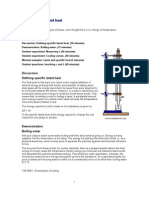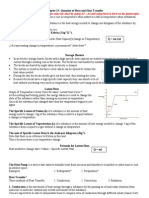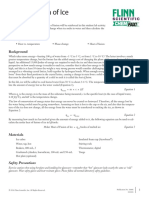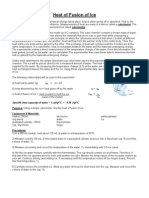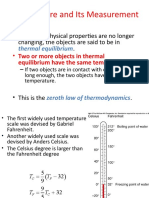0 ratings0% found this document useful (0 votes)
20 viewsSpecific Latent Heat
Specific Latent Heat
Uploaded by
raneshmahabir66The specific latent heat of a substance is the quantity of energy required to change 1 kg of the substance from one phase to another at constant temperature. To determine the specific latent heat of fusion of ice, one melts small pieces of ice in water while measuring the temperature change and mass of ice melted. Using the principle of conservation of energy, the specific latent heat of fusion can be calculated. Similarly, to determine the specific latent heat of vaporization of water, one boils water in an insulated beaker for 15 minutes while measuring the mass of water boiled off to calculate the specific latent heat using the power input.
Copyright:
© All Rights Reserved
Available Formats
Download as PPTX, PDF, TXT or read online from Scribd
Specific Latent Heat
Specific Latent Heat
Uploaded by
raneshmahabir660 ratings0% found this document useful (0 votes)
20 views10 pagesThe specific latent heat of a substance is the quantity of energy required to change 1 kg of the substance from one phase to another at constant temperature. To determine the specific latent heat of fusion of ice, one melts small pieces of ice in water while measuring the temperature change and mass of ice melted. Using the principle of conservation of energy, the specific latent heat of fusion can be calculated. Similarly, to determine the specific latent heat of vaporization of water, one boils water in an insulated beaker for 15 minutes while measuring the mass of water boiled off to calculate the specific latent heat using the power input.
Copyright
© © All Rights Reserved
Available Formats
PPTX, PDF, TXT or read online from Scribd
Share this document
Did you find this document useful?
Is this content inappropriate?
The specific latent heat of a substance is the quantity of energy required to change 1 kg of the substance from one phase to another at constant temperature. To determine the specific latent heat of fusion of ice, one melts small pieces of ice in water while measuring the temperature change and mass of ice melted. Using the principle of conservation of energy, the specific latent heat of fusion can be calculated. Similarly, to determine the specific latent heat of vaporization of water, one boils water in an insulated beaker for 15 minutes while measuring the mass of water boiled off to calculate the specific latent heat using the power input.
Copyright:
© All Rights Reserved
Available Formats
Download as PPTX, PDF, TXT or read online from Scribd
Download as pptx, pdf, or txt
0 ratings0% found this document useful (0 votes)
20 views10 pagesSpecific Latent Heat
Specific Latent Heat
Uploaded by
raneshmahabir66The specific latent heat of a substance is the quantity of energy required to change 1 kg of the substance from one phase to another at constant temperature. To determine the specific latent heat of fusion of ice, one melts small pieces of ice in water while measuring the temperature change and mass of ice melted. Using the principle of conservation of energy, the specific latent heat of fusion can be calculated. Similarly, to determine the specific latent heat of vaporization of water, one boils water in an insulated beaker for 15 minutes while measuring the mass of water boiled off to calculate the specific latent heat using the power input.
Copyright:
© All Rights Reserved
Available Formats
Download as PPTX, PDF, TXT or read online from Scribd
Download as pptx, pdf, or txt
You are on page 1of 10
Specific Latent Heat
https://www.nagwa.com/en/lessons/396102687605/
The specific latent heat of a substance is the quantity
of energy required to change 1 kg of the substance
from one phase to another at a constant
temperature
The equation Eʜ = ml can be used to calculate the
specific latent heat (l) of the substance
Specific Latent Heat of Fusion of Ice
To determine the specific latent heat of fusion of ice
Find the mass of a clean, dry polystyrene cup with a
drinking straw (used as a stirrer)
Half fill the cup with water that has been previously
warmed to 15⁰C above room temperature
Determine the new mass of the cup with the water
and straw and hence determine mw the mass of the
water in the cup
When the temperature of the water in the cup is
about 10⁰C above room temperature (this
temperature should be accurately recorded with a
thermometer, while stirring) start adding small pieces
of ice, previously dried on a tissue to remove water
Add one piece at a time and stir until all the ice is
melted before adding another piece
Keep repeating this until the final water temperature
is about 10⁰C below the room temperature
Record this temperature
Next weigh the cup with cold water to find the total
mass and thus the mass mi of ice melted
The changes taking place are:
Ice water at 0⁰C (change of state, so temperature is constant)
Water from ice at 0⁰C water in cup at θf⁰C
(change of temperature of water = θf⁰C)
Water initially in cup at θi⁰C water in cup at
(where θi = initial temperature of water in cup
and θf = final temperature of water in cup)
While the ice gains heat and melts the water
and calorimeter are both losing the same
amount of heat (to melt the ice and raise the
temperature of the water formed from it)
By the Principle of Conservation of Energy:
Heat lost by water Heat gained Heat gained
originally in cup = by ice + by water
formed
from ice
mw cw (θi – θf ) = mi l + mi cw (θf - 0)
By substituting for mw, cw, θf and θi the value of l
may be found
Note:
The ice should be dried properly with tissue
paper before placing it in the water
When the water and calorimeter are 10⁰C
above room temperature the heat lost (mainly
by radiation) at temperatures above room
temperature is compensated for by adding
enough ice to cool the temperature down to
10⁰C below room temperature when heat is
now gained from the surroundings
The water and ice must be stirred to achieve a
uniform temperature
Specific Latent Heat of Vapourization
To determine the specific latent heat of
vapourization of water
Place the heater in an insulated beaker
of water and switch on
After the water begins to boil note the
reading on the balance and immediately
start a stop-watch
As boiling continues the water
evaporates
Note the reading on the balance every
minute for the next 15 minutes
Suppose a 100W immersion heater is used
Power of heater x time = Heat supplied by
heater to water to
change it to steam
100 x (15 x 60) = ml
If 30g of water is boiled off in this time then
100 x (15 x 60) = 0.03 x l
Note:
One possible error arising in this experiment is
that the can and water lose heat to the
surroundings
Do not let the coil touch the sides or bottom
of the container
You might also like
- Bài Tập Chia Động TừDocument5 pagesBài Tập Chia Động Từ18040137 Lê ĐứcNo ratings yet
- 19c Latent Heat of FusionDocument3 pages19c Latent Heat of FusionAndrae Tennant100% (1)
- Virtues, Vices and Values - The Master List - 2020Document40 pagesVirtues, Vices and Values - The Master List - 2020Andrea Lourdes Di Leo100% (1)
- LATENT HEAT NotesDocument4 pagesLATENT HEAT NotesSowndaryaNo ratings yet
- 1.3.7 Latent HeatDocument12 pages1.3.7 Latent HeattuNo ratings yet
- Lab: Molar Heat of Vaporization and Fusion of WaterDocument1 pageLab: Molar Heat of Vaporization and Fusion of Waterkyle_tosh3382No ratings yet
- Experiment 11 Specific Heat and Heat of Fusion: PreparationDocument5 pagesExperiment 11 Specific Heat and Heat of Fusion: PreparationMae Joy PalmaNo ratings yet
- Thermal Physics PartDocument17 pagesThermal Physics PartSammyJayNo ratings yet
- Specific Heat of A LiquidDocument9 pagesSpecific Heat of A LiquidSai Swetha KVNo ratings yet
- Latent Heat of Fusion VaporizationDocument18 pagesLatent Heat of Fusion Vaporizationapi-449002661No ratings yet
- Exp 4 Heat of Fusion-Melting IceDocument7 pagesExp 4 Heat of Fusion-Melting IceEngelbert AddonganNo ratings yet
- LN - 11 - Heat - CL - 9Document8 pagesLN - 11 - Heat - CL - 9cr7theownerofchampionsleagueNo ratings yet
- Phys 23 T3 The Latent Heat of Fusion of IceDocument4 pagesPhys 23 T3 The Latent Heat of Fusion of IceWynlor AbarcaNo ratings yet
- 13B Heat of FusionDocument8 pages13B Heat of FusionManish KumarNo ratings yet
- HT1-2 - (Quantity of Heat) v2Document17 pagesHT1-2 - (Quantity of Heat) v2Alrence BajumNo ratings yet
- The Latent Heat of Fusion of Ice PDFDocument4 pagesThe Latent Heat of Fusion of Ice PDFNaeem GulNo ratings yet
- Home Experiment For Measuring The Latent Heat of IceDocument2 pagesHome Experiment For Measuring The Latent Heat of IcechlronaldNo ratings yet
- Episode 608: Latent HeatDocument16 pagesEpisode 608: Latent HeatRichard OlawoyinNo ratings yet
- TUP Application Demo (Quantity of Heat)Document28 pagesTUP Application Demo (Quantity of Heat)Coleen AmadoNo ratings yet
- The Latent Heat of Fusion of IceDocument4 pagesThe Latent Heat of Fusion of Iceeid elsayedNo ratings yet
- Calorimetry 2023Document10 pagesCalorimetry 2023Yatharth TiwariNo ratings yet
- Calorimetry Thermal Expansion Theory EDocument20 pagesCalorimetry Thermal Expansion Theory EVaibhav JainNo ratings yet
- Lesson 3 Energy and Phase ChangesDocument22 pagesLesson 3 Energy and Phase Changesyour mamaNo ratings yet
- Thermochemistry (Solutions)Document16 pagesThermochemistry (Solutions)MarikNo ratings yet
- To Find The Specific Latent Heat of Fusion of IceDocument4 pagesTo Find The Specific Latent Heat of Fusion of IcelalNo ratings yet
- Determination of The Enthalpy of Fusion of A Pure Substance (WATER)Document13 pagesDetermination of The Enthalpy of Fusion of A Pure Substance (WATER)Stephen AbeladaNo ratings yet
- Week 9 Phys LabDocument3 pagesWeek 9 Phys LabJacob JohnsonNo ratings yet
- VFKWJDHWJDJJWDocument11 pagesVFKWJDHWJDJJWril.kidnamed.fingerNo ratings yet
- ThermalDocument4 pagesThermalgauravNo ratings yet
- CalorimetryDocument12 pagesCalorimetrySharad SrivastavaNo ratings yet
- Ap 10 Ps em Qa 01 Heat 5Document3 pagesAp 10 Ps em Qa 01 Heat 5VikashNo ratings yet
- 212 Latent Heat of Water BunsenDocument1 page212 Latent Heat of Water BunsenCostas PaschalidesNo ratings yet
- Latent Heat VaporizationDocument3 pagesLatent Heat VaporizationerorkinNo ratings yet
- Justin Myers - EXPERIMENT NUMBER 5 - LATENT HEAT OF FUSION OF ICEDocument6 pagesJustin Myers - EXPERIMENT NUMBER 5 - LATENT HEAT OF FUSION OF ICEdwayne.walker.junior.1320No ratings yet
- Heat Fusion of Ice ReportDocument8 pagesHeat Fusion of Ice Reporthasifah abdazizNo ratings yet
- To Measure The Specific Latent Heat of Vaporisation of WaterDocument4 pagesTo Measure The Specific Latent Heat of Vaporisation of WaterMMGNo ratings yet
- PHYS101L Experiment 107 PDFDocument8 pagesPHYS101L Experiment 107 PDFRandy MolejonaNo ratings yet
- 210 Latent Heat of IceDocument2 pages210 Latent Heat of IceCostas PaschalidesNo ratings yet
- Physics: Heat TransferDocument18 pagesPhysics: Heat TransferDuncan KingNo ratings yet
- With LVDocument8 pagesWith LVRIFAT CHOWDHURYNo ratings yet
- Heat of Fusion of Ice: ScientificDocument4 pagesHeat of Fusion of Ice: ScientificSubha ShankareeNo ratings yet
- Heat: A Measurable Form of Energy: CalorimetryDocument8 pagesHeat: A Measurable Form of Energy: CalorimetryAman LilaniNo ratings yet
- Heat of Fusion of IceDocument2 pagesHeat of Fusion of IceReyna Federo100% (1)
- PHY166 11 ThermodynamicsDocument11 pagesPHY166 11 ThermodynamicsHenok AsnakeNo ratings yet
- PHYSICS 151 - Notes For Online Lecture #35: Latent HeatDocument4 pagesPHYSICS 151 - Notes For Online Lecture #35: Latent HeatsofiajameNo ratings yet
- Temperature and Its Measurement: - When The Physical Properties Are No Longer Changing, The Objects Are Said To Be inDocument17 pagesTemperature and Its Measurement: - When The Physical Properties Are No Longer Changing, The Objects Are Said To Be inPriyanga PremNo ratings yet
- CSEC Physics Expt. 8. Latent HeatDocument3 pagesCSEC Physics Expt. 8. Latent HeatWHITTINHGAM RAYANNANo ratings yet
- Heat capacity of caloriemeterDocument2 pagesHeat capacity of caloriemetertejavardhan693No ratings yet
- TITLE: Latent Heat Lab Number: 9 DATE: February 22, 2018 AIM: To Determine The Specific Latent Heat of Water Apparatus and MaterialsDocument4 pagesTITLE: Latent Heat Lab Number: 9 DATE: February 22, 2018 AIM: To Determine The Specific Latent Heat of Water Apparatus and Materialstashy richardsNo ratings yet
- Z4 X 8 LEXX1 T NSD Hob 3 I 48Document2 pagesZ4 X 8 LEXX1 T NSD Hob 3 I 48Purnima ENo ratings yet
- Thermal PhysicsDocument4 pagesThermal PhysicsCheku DorjiNo ratings yet
- C of WaterDocument3 pagesC of WaterPaul DhuNo ratings yet
- Heating and Cooling Curve Calculations v2Document2 pagesHeating and Cooling Curve Calculations v2MasonNo ratings yet
- Experiment 6 CalorimetryDocument4 pagesExperiment 6 CalorimetryJoshua EgallaNo ratings yet
- Episode 608 - Latent Heat - 1 - 0Document16 pagesEpisode 608 - Latent Heat - 1 - 0revetalkNo ratings yet
- Heat of Neutralization LabDocument2 pagesHeat of Neutralization Labmunira9450% (2)
- HeatDocument2 pagesHeatarumugam gopalNo ratings yet
- Heat Capacity and Specific Heat PDFDocument2 pagesHeat Capacity and Specific Heat PDFAbdel Fattah Hussein Ahmed50% (2)
- Mechanics of the Household: A Course of Study Devoted to Domestic Machinery and Household Mechanical AppliancesFrom EverandMechanics of the Household: A Course of Study Devoted to Domestic Machinery and Household Mechanical AppliancesNo ratings yet
- Boom! 50 Fantastic Science Experiments to Try at Home with Your Kids (PB)From EverandBoom! 50 Fantastic Science Experiments to Try at Home with Your Kids (PB)No ratings yet
- Pressure, Heat and Temperature - Physics for Kids - 5th Grade | Children's Physics BooksFrom EverandPressure, Heat and Temperature - Physics for Kids - 5th Grade | Children's Physics BooksNo ratings yet
- Preoperative Risk Assessment / Clearance FormDocument1 pagePreoperative Risk Assessment / Clearance FormEster Lugo CapcoNo ratings yet
- Two Wheeler Standalone OD Only: Certificate of Insurance Cum Policy ScheduleDocument3 pagesTwo Wheeler Standalone OD Only: Certificate of Insurance Cum Policy ScheduleMohd UvaisNo ratings yet
- 2018.08.03-ICS - Environmental Auditor GuidelineDocument114 pages2018.08.03-ICS - Environmental Auditor GuidelineXavier BaudequinNo ratings yet
- UT30H English ManualDocument1 pageUT30H English ManualToni NavarroNo ratings yet
- How DPF Cleaner Works Complete GuideDocument2 pagesHow DPF Cleaner Works Complete GuideArmeen AminNo ratings yet
- 2022 - Pollution Potential of Jaggery Industry - A Case StudyDocument5 pages2022 - Pollution Potential of Jaggery Industry - A Case Studyraahul.krishnaNo ratings yet
- Pressure Packing PresentationDocument20 pagesPressure Packing PresentationVIJAYIOCL100% (3)
- Hy 1000 SiDocument55 pagesHy 1000 SiMatilda DuncanNo ratings yet
- Einar 614 Product Profile PDFDocument4 pagesEinar 614 Product Profile PDFThanh Linh NguyenNo ratings yet
- Irc 097-1987Document10 pagesIrc 097-1987kruttika_apNo ratings yet
- Swot N Pest Analysis of Nestle and Coca ColaDocument4 pagesSwot N Pest Analysis of Nestle and Coca Colad-fbuser-18320266100% (2)
- The Living WorldDocument5 pagesThe Living WorldAli AnsariNo ratings yet
- HR Strategic Plan: Bounce FitnessDocument6 pagesHR Strategic Plan: Bounce FitnessHendNo ratings yet
- Industrial Relations in IndiaDocument2 pagesIndustrial Relations in IndiaVijay S KumarNo ratings yet
- Sigma Group of Institute: Sub - Learning From Great Indian ThinkersDocument16 pagesSigma Group of Institute: Sub - Learning From Great Indian ThinkersPAVAN KHUSHALARAM SUTHARNo ratings yet
- A Strategic Chess Opening Repertoire For White PDFDocument6 pagesA Strategic Chess Opening Repertoire For White PDFRafaella LemosNo ratings yet
- Elna Elinita EF72 Sewing Machine Service ManualDocument46 pagesElna Elinita EF72 Sewing Machine Service ManualiliiexpugnansNo ratings yet
- ServiceManual Ice o Matic 0320fa4 180 KG DiaDocument174 pagesServiceManual Ice o Matic 0320fa4 180 KG DiaAire Acondicionado Frio Relativo Eirl100% (1)
- Working Mothers Are Benefiting The FamilyDocument3 pagesWorking Mothers Are Benefiting The FamilyOmar BelazriNo ratings yet
- Specificatii Tehnice GazelleDocument2 pagesSpecificatii Tehnice GazellethrewawayNo ratings yet
- NEETPG 2023 StrikeRate PrepLadder PDFDocument542 pagesNEETPG 2023 StrikeRate PrepLadder PDFAviNo ratings yet
- Silva UltraMind On-Line CourceDocument62 pagesSilva UltraMind On-Line CourceAmerican Express100% (1)
- Envicool XRow Cooling SolutionDocument16 pagesEnvicool XRow Cooling SolutionMark PallayaNo ratings yet
- Process Safety and Environmental Protection Volume Issue 2014 (Doi 10.1016/j.psep.2014.04.010) Lee, Chai Siah Robinson, John Chong, Mei Fong - A Review On Application of Flocculants I PDFDocument69 pagesProcess Safety and Environmental Protection Volume Issue 2014 (Doi 10.1016/j.psep.2014.04.010) Lee, Chai Siah Robinson, John Chong, Mei Fong - A Review On Application of Flocculants I PDFSasmi NopiyaniNo ratings yet
- KreditBee CashFree Merchant ListDocument222 pagesKreditBee CashFree Merchant ListNeeraj valmikiNo ratings yet
- Convective Heat Transfer CoefficientDocument1 pageConvective Heat Transfer Coefficientjlcheefei9258No ratings yet
- 16V4000M63L - Heat Exchanger Separate From EngineDocument23 pages16V4000M63L - Heat Exchanger Separate From EngineSarah KirkNo ratings yet
- Documentary Requirements For Common Government Transactions As Per COA Circular NoDocument1 pageDocumentary Requirements For Common Government Transactions As Per COA Circular NoJoji Marie PalecNo ratings yet

















